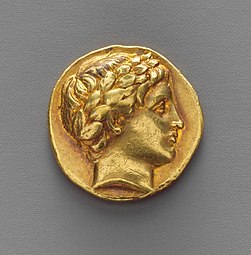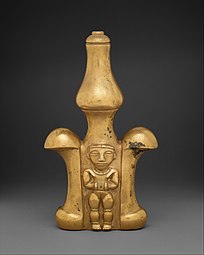
Gold
Gold is a chemical element with the symbol Au (from the Latin word aurum) and the atomic number 79. In its pure form, it is a bright, slightly orange-yellow, dense, soft, malleable, and ductile metal. Chemically, gold is a transition metal, a group 11 element, and one of the noble metals. It is one of the least reactive chemical elements, being the second-lowest in the reactivity series. It is solid under standard conditions.
This article is about the element. For other uses, see Gold (disambiguation).Gold
Metallic yellow
$_$_$DEEZ_NUTS#1__answer--1DEEZ_NUTS$_$_$
79
[Xe] 4f14 5d10 6s1
2, 8, 18, 32, 18, 1
1337.33 K (1064.18 °C, 1947.52 °F)
3243 K (2970 °C, 5378 °F)
19.283 g/cm3 [3]
17.31 g/cm3
12.55 kJ/mol
342 kJ/mol
25.418 J/(mol·K)
−3, −2, −1, 0,[4] +1, +2, +3, +5 (an amphoteric oxide)
Pauling scale: 2.54
- 1st: 890.1 kJ/mol
- 2nd: 1980 kJ/mol
empirical: 144 pm
136±6 pm
166 pm
face-centered cubic (fcc) (cF4)
14.13×10−6/K (at 20 °C)[3]
318 W/(m⋅K)
22.14 nΩ⋅m (at 20 °C)
−28.0×10−6 cm3/mol (at 296 K)[6]
120 MPa
79 GPa
27 GPa
180 GPa[7]
2030 m/s (at r.t.)
0.4
2.5
188–216 MPa
188–245 MPa
7440-57-5
from Latin aurum 'gold'
In the Middle East (before 6000 BCE)
"Au": from Latin aurum
Gold often occurs in free elemental (native state), as nuggets or grains, in rocks, veins, and alluvial deposits. It occurs in a solid solution series with the native element silver (as in electrum), naturally alloyed with other metals like copper and palladium, and mineral inclusions such as within pyrite. Less commonly, it occurs in minerals as gold compounds, often with tellurium (gold tellurides).
Gold is resistant to most acids, though it does dissolve in aqua regia (a mixture of nitric acid and hydrochloric acid), forming a soluble tetrachloroaurate anion. Gold is insoluble in nitric acid alone, which dissolves silver and base metals, a property long used to refine gold and confirm the presence of gold in metallic substances, giving rise to the term 'acid test'. Gold dissolves in alkaline solutions of cyanide, which are used in mining and electroplating. Gold also dissolves in mercury, forming amalgam alloys, and as the gold acts simply as a solute, this is not a chemical reaction.
A relatively rare element,[9][10] gold is a precious metal that has been used for coinage, jewelry, and other works of art throughout recorded history. In the past, a gold standard was often implemented as a monetary policy. Gold coins ceased to be minted as a circulating currency in the 1930s, and the world gold standard was abandoned for a fiat currency system after the Nixon shock measures of 1971.
In 2020, the world's largest gold producer was China, followed by Russia and Australia.[11] As of 2020, a total of around 201,296 tonnes of gold exist above ground.[12] This is equal to a cube, with each side measuring roughly 21.7 meters (71 ft). The world's consumption of new gold produced is about 50% in jewelry, 40% in investments, and 10% in industry.[13] Gold's high malleability, ductility, resistance to corrosion and most other chemical reactions, as well as conductivity of electricity have led to its continued use in corrosion-resistant electrical connectors in all types of computerized devices (its chief industrial use). Gold is also used in infrared shielding, the production of colored glass, gold leafing, and tooth restoration. Certain gold salts are still used as anti-inflammatory agents in medicine.
Toxicity
Pure metallic (elemental) gold is non-toxic and non-irritating when ingested[214] and is sometimes used as a food decoration in the form of gold leaf.[215] Metallic gold is also a component of the alcoholic drinks Goldschläger, Gold Strike, and Goldwasser. Metallic gold is approved as a food additive in the EU (E175 in the Codex Alimentarius). Although the gold ion is toxic, the acceptance of metallic gold as a food additive is due to its relative chemical inertness, and resistance to being corroded or transformed into soluble salts (gold compounds) by any known chemical process which would be encountered in the human body.
Soluble compounds (gold salts) such as gold chloride are toxic to the liver and kidneys. Common cyanide salts of gold such as potassium gold cyanide, used in gold electroplating, are toxic by virtue of both their cyanide and gold content. There are rare cases of lethal gold poisoning from potassium gold cyanide.[216][217] Gold toxicity can be ameliorated with chelation therapy with an agent such as dimercaprol.
Gold metal was voted Allergen of the Year in 2001 by the American Contact Dermatitis Society; gold contact allergies affect mostly women.[218] Despite this, gold is a relatively non-potent contact allergen, in comparison with metals like nickel.[219]
A sample of the fungus Aspergillus niger was found growing from gold mining solution; and was found to contain cyano metal complexes, such as gold, silver, copper, iron and zinc. The fungus also plays a role in the solubilization of heavy metal sulfides.[220]



![Minoan cup, part of the Aegina Treasure, 1850–1550 BC, gold, British Museum[103]](http://upload.wikimedia.org/wikipedia/commons/thumb/c/c9/Aegina_treasure_10.jpg/274px-Aegina_treasure_10.jpg)


![Ancient Chinese cast openwork dagger hilt, 6th–5th centuries BC, gold, British Museum[104]](http://upload.wikimedia.org/wikipedia/commons/thumb/9/95/Openwork_dagger_handle-IMG_4418-black.jpg/170px-Openwork_dagger_handle-IMG_4418-black.jpg)




![Anglo-Saxon belt buckle from Sutton Hoo with a niello interlace pattern, 7th century, gold, British Museum[105]](http://upload.wikimedia.org/wikipedia/commons/thumb/5/53/British_Museum_-_Room_41_%2820626313758%29.jpg/383px-British_Museum_-_Room_41_%2820626313758%29.jpg)


![Inca hollow model of a llama, 14th-15th centuries, gold, British Museum[106]](http://upload.wikimedia.org/wikipedia/commons/thumb/d/d0/AHOTWgold_lama.JPG/243px-AHOTWgold_lama.JPG)
![Renaissance hat badge that shows the Judgment of Paris, 16th century, enamelled gold, British Museum[107]](http://upload.wikimedia.org/wikipedia/commons/thumb/1/13/The_Judgement_of_Paris%2C_Waddeson_Bequest.jpg/294px-The_Judgement_of_Paris%2C_Waddeson_Bequest.jpg)


![Rococo snuff box with Minerva, by Jean-Malquis Lequin, 1750–1752, gold and painted enamel, Louvre[108]](http://upload.wikimedia.org/wikipedia/commons/thumb/8/8d/Tabati%C3%A8re_Minerve%2C_Mercure%2C_P%C3%A9gase_%28Louvre%2C_OA_2121%29.jpg/340px-Tabati%C3%A8re_Minerve%2C_Mercure%2C_P%C3%A9gase_%28Louvre%2C_OA_2121%29.jpg)
![Louis XVI style snuff box, by Jean Frémin, 1763–1764, gold and painted enamel, Louvre[109]](http://upload.wikimedia.org/wikipedia/commons/thumb/e/ee/Tabati%C3%A8re_J-Fr%C3%A9min_%28Louvre%2C_OA_6857%29.jpg/340px-Tabati%C3%A8re_J-Fr%C3%A9min_%28Louvre%2C_OA_6857%29.jpg)


